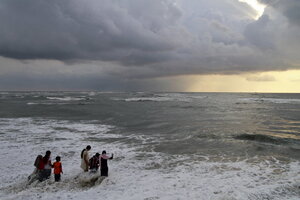Earthquakes: Another source of global-warming gas, scientists say
A team of scientists has linked a major earthquake in southwest Asia in 1945 to the ongoing release of methane gas from the Arabian seafloor.

Beachgoers wade into the Arabian Sea in the Indian state of Kerala. A team of scientists has found that a 1945 earthquake there released trapped methane from the seafloor, a find that could have bearing on future climate models.
Sivaram V/Reuters
A devastating earthquake in 1945 sent millions of cubic feet of methane bubbling up to the earth’s surface, scientists have found, in new research that could add another source of the greenhouse gas to future climate models.
The latest research joins burgeoning scientific interest in the potential contribution of methane, a greenhouse gas that is significantly more effective as a heat trapper than carbon dioxide, to global warming. Last week, a separate article in Nature called the methane gas below the Arctic “a global economic time-bomb,” referring to the potential costs to the world should global warming thin the Arctic ice enough to release the gas there.
This latest paper, though, identifies not a manmade source of atmospheric methane, but a natural one: earthquakes.
“It had earlier been speculated that there was a direct connection between earthquakes and methane seepage,” says David Fischer, a postdoctoral researcher at the University of Bremen in Germany and the lead author on the paper, published in Nature Geoscience. “But we are the first to prove it and suggest the mechanistic natural process behind it.”
Fischer and his team began their project looking not necessarily for an earthquake-methane link, but for a general portrait of where methane could be found in marine sediments. First, the team analyzed sediments drilled in 2007 from the northern Arabian Sea, near Pakistan’s coast. Sure enough, there was methane there: one of those cores had methane just 5.2 feet below the sea floor, a sign of some cataclysmic event that has sent the gas surging upward, the scientists found.
And that event, the scientists realized, was readily available: an 8.1 magnitude earthquake – the strongest earthquake ever reported in the Arabian Sea – had roiled southwestern Asia in 1945, sending a tsunami plunging into India and Pakistan and killing some 4,000 people.
“We wanted to investigate if, and where, methane seeps out of the sediments,” says Dr. Fischer. “Only at a later stage we inferred a causal relation of the seepage and the earthquake. This was not entirely anticipated.”
Overall, the team found that some 261 million cubic feet of methane have leaked up to the earth’s surface during the few decades following the major earthquake. That seepage is ongoing, the scientists said.
Major earthquakes and their associated methane gas release could be an included factor in future climate change models, though much research is still needed to determine how much that gas might influence global warming, Fischer said.
"We simply can´t tell yet, if and how much our findings affect climate models,” says Fischer. “Maybe it turns out to be important, maybe it doesn't. We´ll see."
"We just wanted to make sure that those colleagues writing the (very important!) IPCC-reports [Intergovernmental Panel on Climate Change reports] are aware there might be another source of methane/carbon to the environment,” he says.

